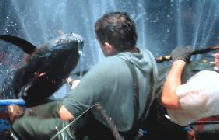|
A typical set consists of 200 or more "units/baskets" connected together, with a buoy at each connection, and a total of about 3000 hooks.
The gear is released in a continuous way, each hook being baited just before leaving the vessel's deck.
The vessel steams at between 9.5 knots and 11.5 knots. The longline is paid out from the aft storage wells on the upper deck through a series of PVC pipes and a hydraulic line feeder, situated on the lower deck amidships, at a rate of about 450 m per minute (27 km per hour).
The depth of the mainline can be varied by changing the speed of the feeder and the speed of the vessel.
The rate at which branchlines (snoods) and buoylines are attached to the mainline, and therefore the space between snoods, is controlled from the wheelhouse.
Radio buoys are used for locating the line at the start of the haul or in the event of a broken line.
Between 2500 and 3000 hooks are set over a total distance of about 100 km, taking about five or six hours to complete each set. At least five crewmembers are required for the setting.
After the last radio buoy is set, the crew retire for about four hours before the start of the hauling operation.
In general the starting time for hauling the lines depends upon the number of baskets set.
Hauling longlines
Hauling usually takes at least 11 hours, and requires at least a dozen crewmembers. The last radio buoy set is usually the first to be hauled on board. It is located with the help of the radio direction finder or by radar, and is hauled on board and detached from the mainline.
The mainline is threaded over roller guides and through the hydraulic mainline hauler. The speed of recovery is controlled by a crewmember. The mainline coils under its own tension from the hauler onto a conveyor belt which carries it across the deck from starboard to port side. Any tangles in the mainlines are removed as it moves along on the conveyor belt.
The vessel steams along the mainline at an average speed of about 6 knots, with the line retrieved over the starboard side at a rate of between 150 and 250 m per minute.
Branchlines are unclipped off the mainline as they come over the side of the vessel or after they go through the line hauler.
The snoods are coiled, either by hand or with an automatic coiler, and are tied off around the hook with a loop of the line near the clip, then packed into bundles of approximately 20 in baskets.
These bundles or baskets and the buoys are placed at intervals onto a conveyor belt on the port side of the vessel. This takes them to the crewmember who is packing the mainline into the aft wells and they are then stacked at the stern ready for the next set.
Landing the catch
When a large fish is detected on a line, the vessel slows,
and may turn to starboard to follow the fish.
When the fish is brought alongside the vessel,
a gaff or a harpoon is used to land it, spearing the fish in the head.
Once landed, the monofilament line is cut so the hooks remain in the mouth until dressing. This practice makes handling of the catch much easier.
|


